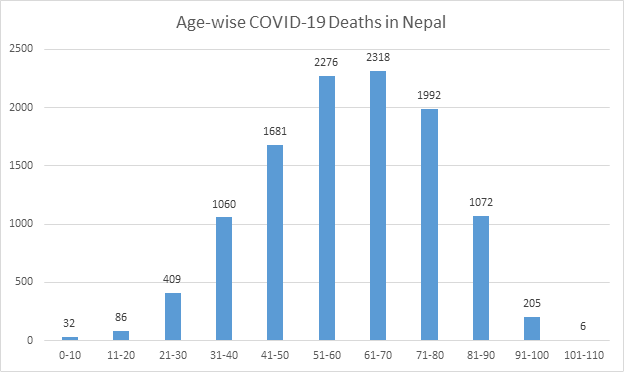Kathmandu: As in global trends of Covid-19 mortality rate, male deaths from COVID-19 in Nepal are double than female deaths while age-wise deaths constitute inconsistent ratio though elderly died higher due to the pandemic.
The data of the Ministry of Health and Population (MoHP) shows that number of male deaths from Covid-19 is double compared to the number of female deaths.
Due to the Covid-19, among 11,152 total deaths, 1,612 people lost their life in Province 1, 768 died in Province 2, 4,772 in Bagmati Province (3), 1,323 in Gandaki Province (4), 1,732 in Lumbini Province (5), 461 in Karnali Province (6), and 484 in Sudurpaschim Province (7). The data reveals that male deaths are twice than the number of female deaths in all provinces.
What’s the reason behind it? Is there a connection with genes, hormones, or the immune system or behavior that makes males more susceptible to the pandemic?

According to the Science Alert, the sex bias in Covid-19 deaths is part of a much larger picture – and a very much older picture – of sex differences in genes, chromosomes and hormones that lead to very different responses to all sorts of disease, including Covid-19.
According to the MOHP, limitedly tested total cases of COVID-19 reached 798,776 on October 5. Of the total cases, 11,180 people died of the pandemic and there are 16,248 active cases now in Nepal while 771,338 got recovered from the disease.
The males also were highly infected from COVID-19 in Nepal as per the data of the MoHP. Similarly, the gender-wise or age-wise death rates in Nepal showed that men are susceptible to the pandemic.
However, the government officials of Nepal said that the infection or higher death rates of males from the disease is a matter of research. “In other diseases, females have strong defense mechanisms biologically but it may be concerned to this virus,” said Dr Sher Bahadur Pun, a virologist at Sukraraj Tropical & Infectious Diseases Hospital, Teku.

Dr Samir Kumar Adhikari, joint-spokesperson for the MoHP, also said that it is an issue of research. “We can’t say more about it now,” he added. “Immunity and biology may be connected to some extent as in other diseases.”
At par with the MoHP, nearly one-third of the population was immunized while some 30 percent were already received full doses of vaccines and over 36 percent got single shots till now. In Kathmandu, over 73 percent of the eligible population for vaccination received the full doses. The country has an estimated population of 30 million.
The government has announced that it will immunize its entire people eligible for vaccination by mid-April 2022. The government has vaccinated the people above 18 years of age as per the availability of vaccines.













Comment